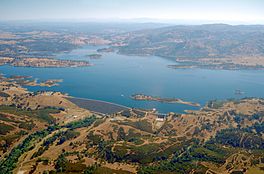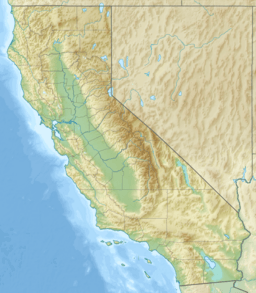New Hogan Lake facts for kids
Quick facts for kids New Hogan Lake |
|
|---|---|

Aerial view of lake and dam. View to the northeast
|
|
| Location | Sierra Nevada Mountains Calaveras County, California |
| Coordinates | 38°09′03″N 120°48′46″W / 38.1507°N 120.8129°W |
| Lake type | Reservoir |
| Primary inflows | Calaveras River |
| Primary outflows | Calaveras River |
| Catchment area | 363 square miles (940 km2) |
| Basin countries | United States |
| Max. length | 3 miles (4.8 km) |
| Max. width | 2 miles (3.2 km) |
| Surface area | 4,410 acres (1,780 ha) |
| Water volume | 317,000 acre-feet (391,000,000 m3) |
| Surface elevation | 666 feet (203 m) |
New Hogan Lake is a man-made lake located in the beautiful foothills of the Sierra Nevada mountains. You can find it in Calaveras County, California, about 30 miles (48 km) northeast of Stockton. This large reservoir was created by the New Hogan Dam on the Calaveras River.
The lake holds a huge amount of water, about 317,000 acre-feet (391 million cubic meters). The dam, which is made of earth, was finished in 1963 and stands 210 feet (64 m) tall. New Hogan Lake is owned by the United States Army Corps of Engineers. It helps prevent floods, provides drinking water, generates electricity, and supplies water for irrigation to farms. It's also a popular spot for fun outdoor activities like boating, fishing, water skiing, and camping.
Contents
The Story of New Hogan Lake
New Hogan Lake and its dam are actually the second version of a project to control the Calaveras River.
Why a Dam Was Needed
Long ago, the Calaveras River used to flood the city of Stockton, California. To stop this, an earlier dam, called Hogan Dam, was built. However, in the 1950s, big floods still happened. This showed that the first dam wasn't big enough to protect the area.
Building the New Dam
Because of the ongoing flood problems, the United States Army Corps of Engineers decided to build a bigger and better dam. Construction on the New Hogan Dam and New Hogan Lake began in 1960 and was finished in 1963. The lake was first filled with water in 1965.
Today, the Army Corps of Engineers manages the lake. Their main jobs are to control floods and provide a place for people to have fun. The lake also supplies water for drinking and farming to local water districts. There's even a small hydroelectric plant at the base of the dam that makes electricity.
Fun Things to Do at New Hogan Lake
New Hogan Lake is a fantastic place for outdoor adventures! There are many activities for everyone to enjoy.
Water Sports and Boating
If you love being on the water, New Hogan Lake is perfect. There are several ramps where you can launch your boat or jet ski. You can enjoy exciting activities like water skiing, wakeboarding, tubing, canoeing, sailing, and of course, fishing.
Camping Adventures
For those who love to camp, the lake has two main campgrounds: Acorn and Oak Knoll.
- Acorn Campground: This is a larger campground with 128 campsites. It has helpful facilities like coin-operated showers, flush toilets, and drinking water.
- Oak Knoll Campground: This site is a bit more private, with 49 campsites. It doesn't have showers and is closed during the lake's off-season.
You can also find special spots for boat-in camping (where you arrive by boat) and group camping.
Day-Use Areas and Picnics
Around the lake, there are several day-use areas where you can spend a fun day. These include Fiddle-neck, Bay Creek, Whiskey Creek, Slate Creek, and Wrinkle Cove. Wrinkle Cove is a free area with benches and grills. It's a great spot for swimming and floating in the lake, even if you don't have a boat.
Fishing and Trails
Fishing is very popular here, both from the shore and on the water. You can catch many different kinds of fish. If you prefer to stay on land, there are trails for hiking, horseback riding, and biking. One famous trail is the "River of Skulls" hiking trail, located in the Monte Vista Recreation area.
Disc Golf and Fireworks
In 2012, two 18-hole disc golf courses were added. The western course is especially cool, with holes right along the water's edge! Every year, near the Fourth of July, there's a wonderful fireworks show over the lake in Valley Springs. It's a big event put on by local volunteers.
Fish Eating Advisory
It's important to know that the California Office of Environmental Health Hazard Assessment (OEHHA) has advice about eating fish from New Hogan Lake. This is because of levels of mercury or PCBs found in some fish species. Always check their guidelines for safe eating.
Animals and Plants at New Hogan Lake
New Hogan Lake is home to many different animals and plants, both on land and in the water.
Birds of the Lake
You can spot many bird species around the lake. Some, like quail, dove, waterfowl, and wild turkey, can be hunted in specific areas. Other birds are just for viewing, such as vultures, bald and golden eagles, osprey, hawks, ducks, and geese.
Fish Species
The lake and the Calaveras River are home to many fish. Some native species include Central Valley Chinook salmon, Central Valley steelhead trout, and Sacramento pike minnow. Sadly, the number of Chinook salmon has dropped a lot since dams were built in California. Efforts are being made to help these fish populations recover.
Common fish that people catch in the lake include striped bass, black bass, catfish, bluegill, and crappie.
Land Animals
Near the lake's shores, you might see blacktail deer, cottontail rabbits, mice, raccoons, striped skunks, gophers, coyotes, mountain lions, grey foxes, bobcats, and moles.
It's very important to be aware of rattlesnakes when you are hiking, biking, or camping around the lake. They are often found in the area, along with other snake species.
How New Hogan Lake Helps with Water Supply
The Calaveras River system gets most of its water from natural waterways. New Hogan Lake is the main storage place for this water.
Water Storage and Flow
New Hogan Lake is centrally located and stores a huge amount of water for the river. The Stockton East Water District and the United States Army Corps of Engineers control how much water flows out of the dam. This affects the water quality and flow of the Calaveras River downstream.
Jenny Lind Water Treatment Plant
Just a mile downstream from New Hogan Lake is the Jenny Lind Water Treatment Plant. This plant, operated by the Calaveras County Water District, cleans water for about 9,592 people. It can treat up to 6 million gallons of water per day. The plant takes raw water directly from the river and cleans it using gravity.
After a big fire called the Butte Fire, there were worries about water quality. The district is working on a project to improve the plant and ensure clean water for everyone.
Drought Effects on New Hogan Lake
Recent droughts have had a big impact on New Hogan Lake.
Lower Water Levels
In January 2013, the lake was about half full. By January 2015, it was only about 16% full! This was one of the lowest levels ever recorded for the lake, especially in September 2014 when it was just 14% full. Even though there was a lot of rain in February 2015, it wasn't enough to fill the reservoir back up completely.
Impact on Water Users
The low water levels during the drought caused problems for the areas that rely on the lake's water. For example, in 2015, the Stockton East Water District warned farmers that they might not get enough water for their crops. While there was enough water for the city of Stockton (with help from the New Melones Dam), there wasn't enough for all the farmers. Farmers with special water rights were given priority.



